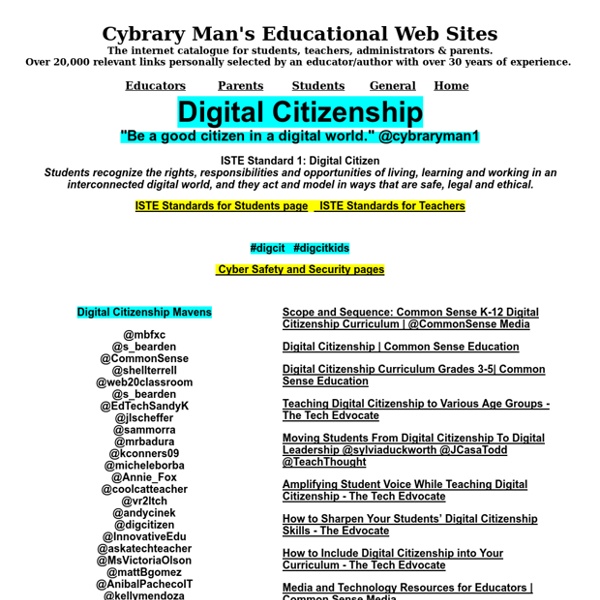



http://cybraryman.com/digcit.html
Related: Digital Citizenship & Safety • Digital TeachingSWGfL Digital Literacy - Curriculum Overview This resource is no longer being updated and may not reflect current policy. Read about our new resource here. Return to the Top KEYFS / Key Stage 1Key Stage 2Key Stage 3Key Stage 4 / 5Download this page (PDF) Scope & Sequence: Common Sense K-12 Digital Citizenship Curriculum Get Trained Use our professional development resources to learn best practices for teaching digital citizenship to your students. Onboard Students: Digital Passport
Digital Citizenship Resources for Family Engagement Media Balance & Well-Being English | Spanish | More Languages (Arabic, Chinese, Farsi, Korean, Russian, Tagalog, Urdu, Vietnamese) Privacy & Security English | Spanish | More Languages (Arabic, Chinese, Farsi, Korean, Russian, Tagalog, Urdu, Vietnamese) Digital Footprint & Identity English | Spanish | More Languages (Arabic, Chinese, Farsi, Korean, Russian, Tagalog, Urdu, Vietnamese) Relationships & Communication English | Spanish | More Languages (Arabic, Chinese, Farsi, Korean, Russian, Tagalog, Urdu, Vietnamese) Cyberbullying, Digital Drama, & Hate Speech English | Spanish | More Languages (Arabic, Chinese, Farsi, Korean, Russian, Tagalog, Urdu, Vietnamese) News & Media Literacy English | Spanish | More Languages (Arabic, Chinese, Farsi, Korean, Russian, Tagalog, Urdu, Vietnamese)
Nine Elements Nine Themes of Digital Citizenship Digital citizenship can be defined as the norms of appropriate, responsible behavior with regard to technology use. 1. Why K–12 Students Need to Be Taught to Guard Their Data Online A recent McAfee survey of 1,000 college students and recent graduates ages 18 to 25 revealed some startling statistics on how little this tech-savvy cohort knows about data security. As many as 80 percent of students surveyed said either they or a friend or family member had been affected by a cyberattack. Despite that, 43 percent said they believed that they wouldn’t ever be a victim of a cybercrime. The consequence? Shockingly poor data hygiene. Just over half (53 percent) of students surveyed had security software on their computers, only 37 percent had smartphone protection and an even lower number, 14 percent, had some security installed on their tablets.
Teaching Students Good Digital Citizenship Teachers have long understood the importance of instilling good citizenship in their students, focusing on social etiquette and how to treat their peers with respect in the course of their daily lives. Today, though, it’s just as important that students understand what kinds of behaviors are acceptable online. Instilling the principles of good digital citizenship can help students become smart, responsible, and respectful members of their online communities.
Real Online Privacy for Beginners: 60+ Essential Tips and Warnings Companies and governments are spying on you all over the internet and beyond. We have all kinds of tips to help you reclaim your privacy online! Quick Links Advertisement Media Literacy: Five Ways Teachers Are Fighting Fake News As the national attention to fake news and the debate over what to do about it continue, one place many are looking for solutions is in the classroom. Since a recent Stanford study showed that students at practically all grade levels can’t determine fake news from the real stuff, the push to teach media literacy has gained new momentum. The study showed that while students absorb media constantly, they often lack the critical thinking skills needed to tell fake news from the real stuff.